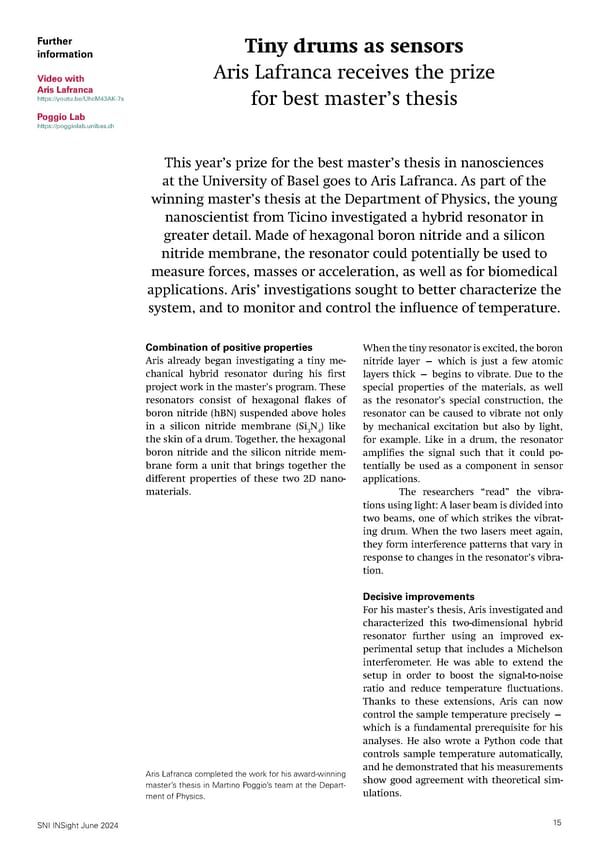Best master's thesis
Aris Lafranca wins the prize for the best master's thesis in nanoscience at the University of Basel.
Further Tiny drums as sensors information Video with Aris Lafranca receives the prize Aris Lafranca https://youtu.be/UhcM43AK-7s for best master’s thesis Poggio Lab https://poggiolab.unibas.ch This year’s prize for the best master’s thesis in nanosciences at the University of Basel goes to Aris Lafranca. As part of the winning master’s thesis at the Department of Physics, the young nanoscientist from Ticino investigated a hybrid resonator in greater detail. Made of hexagonal boron nitride and a silicon nitride membrane, the resonator could potentially be used to measure forces, masses or acceleration, as well as for biomedical applications. Aris’ investigations sought to better characterize the system, and to monitor and control the in昀氀uence of temperature. Combination of positive properties When the tiny resonator is excited, the boron Aris already began investigating a tiny me- nitride layer — which is just a few atomic chanical hybrid resonator during his 昀椀rst layers thick — begins to vibrate. Due to the project work in the master’s program. These special properties of the materials, as well resonators consist of hexagonal 昀氀akes of as the resonator’s special construction, the boron nitride (hBN) suspended above holes resonator can be caused to vibrate not only in a silicon nitride membrane (Si N ) like by mechanical excitation but also by light, 3 4 the skin of a drum. Together, the hexagonal for example. Like in a drum, the resonator boron nitride and the silicon nitride mem- ampli昀椀es the signal such that it could po- brane form a unit that brings together the tentially be used as a component in sensor di昀昀erent properties of these two 2D nano- applications. materials. The researchers “read” the vibra- tions using light: A laser beam is divided into two beams, one of which strikes the vibrat- ing drum. When the two lasers meet again, they form interference patterns that vary in response to changes in the resonator’s vibra- tion. Decisive improvements For his master’s thesis, Aris investigated and characterized this two-dimensional hybrid resonator further using an improved ex- perimental setup that includes a Michelson interferometer. He was able to extend the setup in order to boost the signal-to-noise ratio and reduce temperature 昀氀uctuations. Thanks to these extensions, Aris can now control the sample temperature precisely — which is a fundamental prerequisite for his analyses. He also wrote a Python code that controls sample temperature automatically, Aris Lafranca completed the work for his award-winning and he demonstrated that his measurements master’s thesis in Martino Poggio’s team at the Depart- show good agreement with theoretical sim- ment of Physics. ulations. SNI INSight June 2024 15
 SNI INSight June 2024 Page 14 Page 16
SNI INSight June 2024 Page 14 Page 16